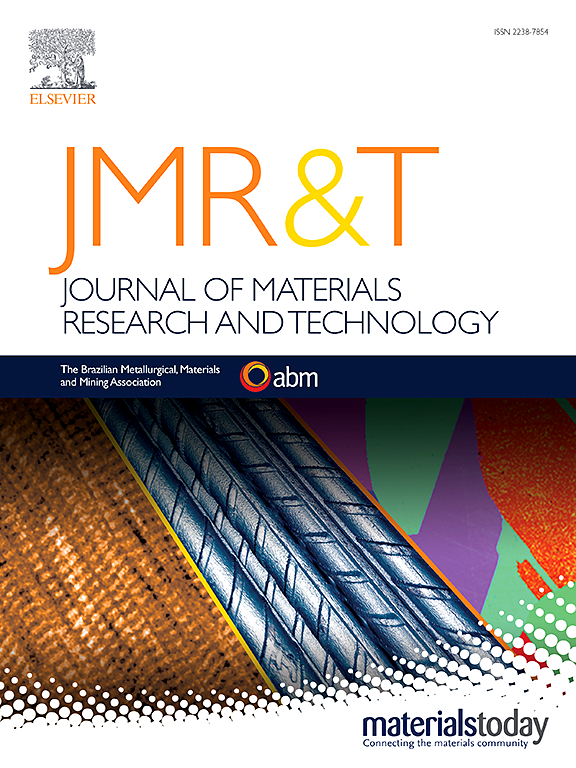Effect of in-situ SiC particles on the room–temperature dry sliding wear behavior of Al–12Si–4Cu–2Ni–1Mg alloys
IF 6.2
2区 材料科学
Q1 MATERIALS SCIENCE, MULTIDISCIPLINARY
Journal of Materials Research and Technology-Jmr&t
Pub Date : 2025-06-12
DOI:10.1016/j.jmrt.2025.06.093
引用次数: 0
Abstract
In-situ SiC particles (SiCip) show significant potential to elevate the wear behavior of Al matrix composites due to the improved SiC/Al interfacial bonding. This study mainly focuses on the effect of SiCip on the room–temperature dry sliding wear behavior of Al–12Si–4Cu–2Ni–1Mg (Al–Si–Cu) alloys under a widely ranged 40–160 N load. SiCip/Al–Si–Cu composites and Al–Si–Cu matrix alloys were obtained via a melt method, with the powder metallurgy Al–12Si-18SiCip composites as the master alloy. The variation pattern of the wear loss and friction coefficient of the composites and the matrix alloys have been explored, the microstructure of the friction surface and the wear debris have been observed, and the wear enhancing and interfacial improving mechanism of SiCip have been discussed. Results show that the wear of SiCip/Al–Si–Cu composites change from mild-to-moderate wear to severe wear at the load 120–160 N. The severe wear of the composites can be marked by the frequent appearance of large lamellar debris. Due to the improved SiC/Al interfacial bonding, SiCip can undergo plastic flow and accumulate at the friction surface during wear, so simultaneously improve the wear resistance and friction coefficient of Al–12Si–4Cu–2Ni–1Mg alloys, especially at high loads. For in-situ coating SiCip, the tress–buffer effect of in-situ coating plays an important role during wear.
原位SiC颗粒对Al-12Si-4Cu-2Ni-1Mg合金室温干滑动磨损行为的影响
原位碳化硅颗粒(SiCip)通过增强SiC/Al界面结合,提高了Al基复合材料的磨损性能。本研究主要研究了SiCip对Al-12Si-4Cu-2Ni-1Mg (Al-Si-Cu)合金在40-160 N载荷下室温干滑动磨损行为的影响。以粉末冶金Al-12Si-18SiCip复合材料为基体合金,采用熔炼法制备了SiCip/ Al-Si-Cu复合材料和Al-Si-Cu基合金。研究了复合材料和基体合金的磨损损失和摩擦系数的变化规律,观察了摩擦表面的微观组织和磨损碎屑,探讨了SiCip的增磨和界面改善机理。结果表明:在120 ~ 160 n载荷下,SiCip/ Al-Si-Cu复合材料的磨损由轻度至中度磨损转变为重度磨损,复合材料的重度磨损表现为频繁出现较大的片层状碎屑;由于SiC/Al界面结合的改善,SiCip在磨损过程中可以在摩擦表面进行塑性流动和积累,从而同时提高了Al - 12si - 4cu - 2ni - 1mg合金的耐磨性和摩擦系数,特别是在高载荷下。对于原位涂层SiCip,原位涂层的应力缓冲作用在磨损过程中起着重要作用。
本文章由计算机程序翻译,如有差异,请以英文原文为准。
求助全文
约1分钟内获得全文
求助全文
来源期刊

Journal of Materials Research and Technology-Jmr&t
Materials Science-Metals and Alloys
CiteScore
8.80
自引率
9.40%
发文量
1877
审稿时长
35 days
期刊介绍:
The Journal of Materials Research and Technology is a publication of ABM - Brazilian Metallurgical, Materials and Mining Association - and publishes four issues per year also with a free version online (www.jmrt.com.br). The journal provides an international medium for the publication of theoretical and experimental studies related to Metallurgy, Materials and Minerals research and technology. Appropriate submissions to the Journal of Materials Research and Technology should include scientific and/or engineering factors which affect processes and products in the Metallurgy, Materials and Mining areas.
 求助内容:
求助内容: 应助结果提醒方式:
应助结果提醒方式:


